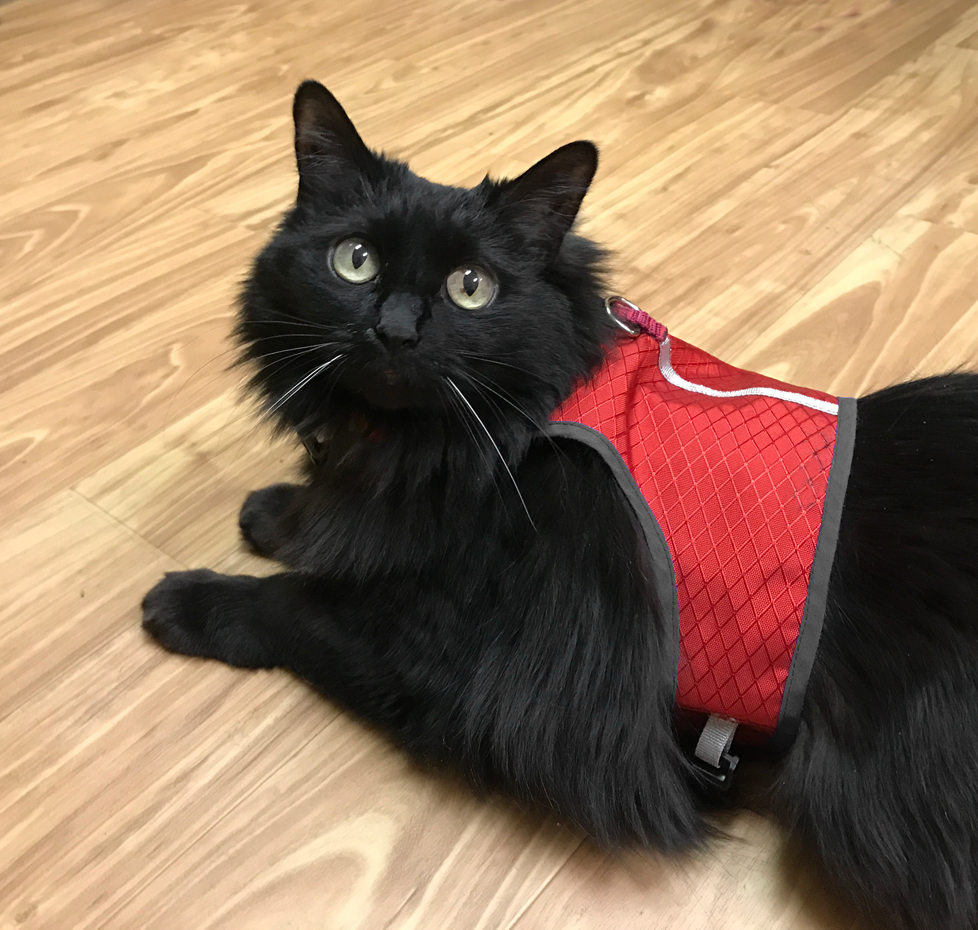Yes, many cats can be trained to walk on a leash! Like anything else, cats need gentle instruction to learn do something that’s foreign to them.
We hear people say they’ve tried harnesses or walking jackets and their cat doesn’t like them.
Cats who have never experienced anything on their backs will often act as if they’ve been caught by a predator: they either flatten and freeze, or fight back. Gentle training can overcome this response.
Why should I leash train my cat?
Many cats live indoors to keep them safe, preventing injuries, illness and premature death. Indoor cats may get bored, obese and develop undesirable behaviors if they don’t have mental and physical stimulation.
A cat who is harness & leash trained has more options for safely traveling and spending time outdoors. Walking in the neighborhood can increase your cats’ confidence by expanding their territory. You can enjoy the experience of having your cat with you in the yard or on the deck.
A cat who is satisfied and well exercised will be a calm and happy housemate for you and other animals in the home.
Is my cat a good candidate for harness training?
First ask yourself, is my cat confident enough to go outside? If your cat runs to hide any time someone new comes to the door or anything new is introduced, you will probably want to avoid harness training. Forcing a shy cat outside only reinforces his or her fears, and can make him even more afraid.
However, if your cat is confident and eager to learn new things, he will probably be a good candidate.

What kind of harness should I use?
You will need a harness, or walking jacket, for your cat. Cat necks are more delicate than dogs’, so using only a collar can hurt them. Please look for one made specifically for cats, like the walking jackets available at Happy Cats Haven.
Cat necks are usually smaller than dogs’ so they need an adjustable collar at the neck. If the collar isn’t adjustable, your cat may be able to slip out of it, especially if frightened.
A good harness or walking jacket should fit snugly, but allow free movement. Some have a very wide collar part that can be uncomfortable for cats, so look for one that your cat will be comfortable in.

How to introduce the harness
Each cat will have his or her own unique reactions to harness training so feel free to modify these steps to fit your cat’s response.
Try not to push him too fast. Allow him to tell you when he’s ready for the next step by relaxing and enjoying the process. Keep the experience positive and have those treats ready!
- Allow your cat to get familiar with the harness and leash by placing them in his sleeping area for a few days. You can even drag the straps and leash to play with him, making it a game while getting his scent on them.
- Once he is familiar with the harness, place it on his back for a few seconds, then remove. Repeat that process, adding a few seconds every time, until he’s comfortable with it on top of him.
- Next, close the collar part around his neck for a few seconds and give him a favorite treat, then remove. Repeat this too, adding seconds each time. Once he’s comfortable with it around his neck, close the torso clasp and repeat. Don’t forget the treats!
- Once he is comfortable wearing the harness, bring out his favorite toy and have playtime while wearing it. This gets him used to the feel of the harness while his favorite activity is happening.
- If your cat acts afraid or uncomfortable, reassure him and take the harness off to try again later. Forcing him will just give him a bad association with the harness. Also end the session if you get frustrated.
How to walk outside
- Walk with your cat around the house at first until he is moving normally in the harness. Introducing him to the outdoors is a completely different step and should be done slowly.
- Choose a safe, quiet location to start, like an enclosed yard or deck. If he has never been outside, you’ll need to get him comfortable with being outside first.
- Pick him up and take him outside to start. This will help train him not to dash out the door on his own. Once outside you can encourage movement with treats.
- Walking a cat is different from walking a dog. You don’t so much walk your cat as let him walk you! You will be keeping him safe and controlled while he has a chance to go out and investigate.
- If he gets frightened, return indoors. Never let him pull back on the harness to try to escape.
- The best position for you to stand is to the side and behind him. You can guide him with gentle sideways pressure on the leash.
- Don’t let him get too far away, especially if there is dense brush around. It is not safe to let a leashed cat climb trees.
- If he gets away, don’t chase after him. Sit on the ground, call him and offer a treat. Stay calm and entice your cat to come to you.
- Create a signal when the walk is over: tell him “Home†and carry him indoors. Give him a treat and remove the harness.

What else should I know?
Train when your cat is hungry and motivated by treats. Have a good supply that you can easily offer to reinforce your cat’s efforts.
Many cats will fall over or freeze when they feel the harness because it triggers a survival response that they would employ if grabbed by a predator. You need to help them move through this instinctual behavior with a highly attractive motivation toy or treat — and lots of praise.
Be confident and praise him as you place him in the harness. If you enjoy the process it will give him confidence.
Go slowly and reward him for small advances. The training will be more successful and you will be out enjoying his company outside sooner if you keep his experience positive.
A note about leashes: try to find ones that are as thin and light as possible. A big, heavy leash will just add more weight and discomfort, especially while training.
If your cat tries to pull out of the harness, immediately slacken the leash. This is easiest if you are standing behind your cat.
While he is getting used to the harness and leash, try not to interrupt the learning process by repeatedly picking him up. Instead, let him learn that the leash allows good things to happen.
However, if he gets very frightened, consider picking him up and ending the session.
Soon your cat will understand that by tolerating the harness, he gets to explore the great outdoors safely. That will be rewarding in itself and you’ll have a cat who loves to go for walks!
Additional leash & harness training resources
Should You Walk Your Cat? Great Jackson Galaxy video that also includes clicker training
Nine Lives, One Leash: another Jackson Galaxy video about consulting with a client on leash training
Where to find safe harnesses (remember, don’t use a dog harness):
- Right here at Happy Cats!
327 Manitou Avenue, Manitou Springs, CO 80829 - Safety Katz Walking Jackets
- Cozy Cat Harness Pattern for DIY
- Good2Go Cat Harness & Leash set at Petco





